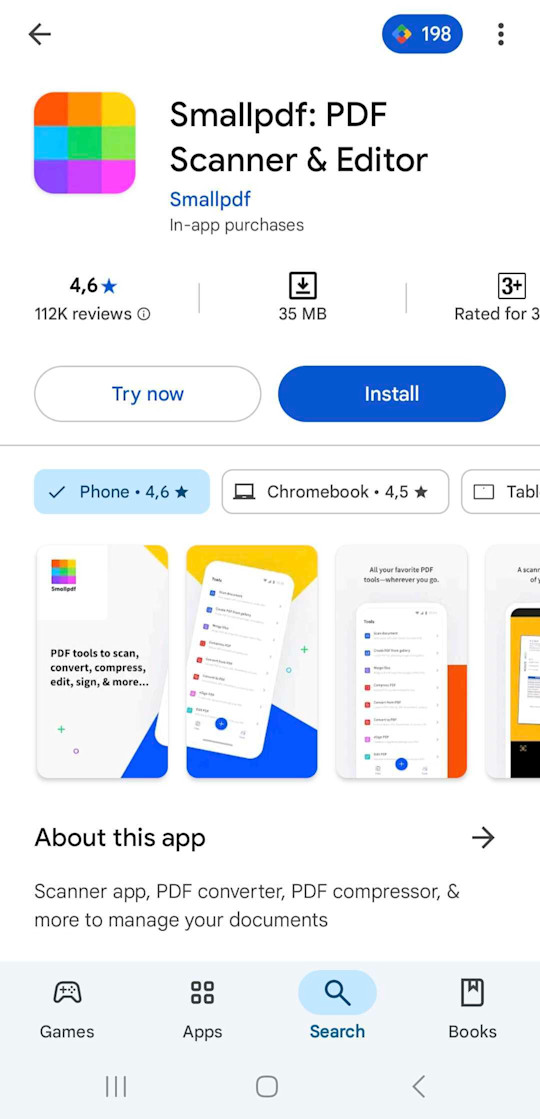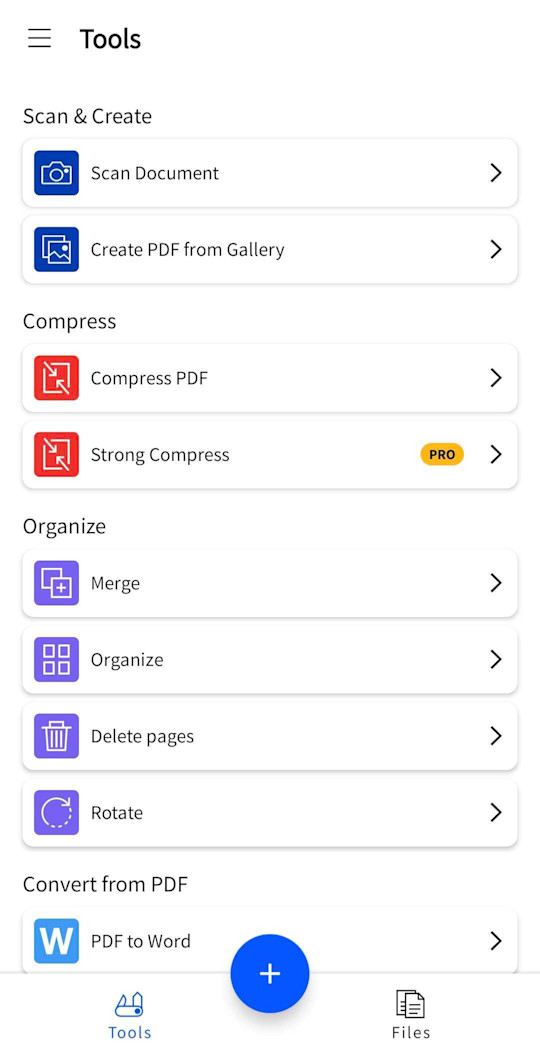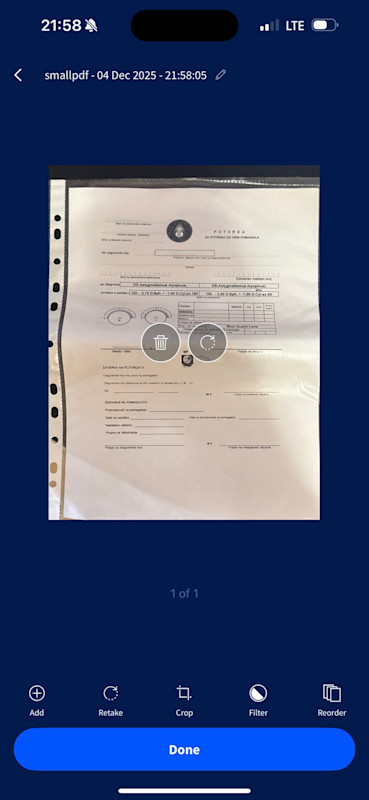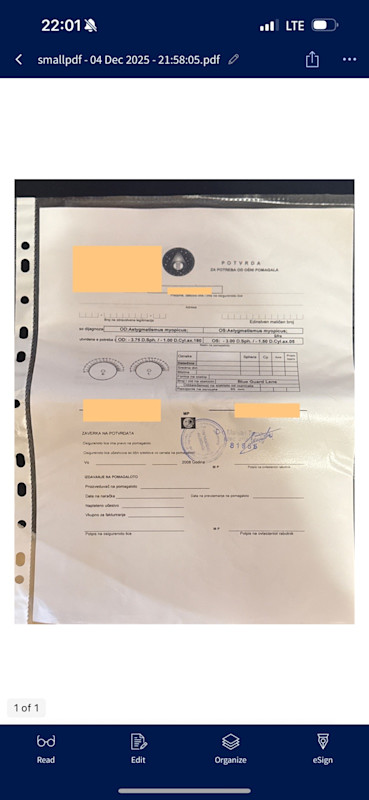
Learn how to scan legal size paper to PDF. Plus, how to troubleshoot common issues, and handle scanners that don’t support 14-inch papers.
If you work with contracts, agreements, or court documents, you will often need to scan legal size paper into clean, readable PDFs.
To do it right, you have to match the paper size on the scanner with the settings in your scan software or app. You can do this on a flatbed scanner, an automatic document feeder (ADF), or with our Smallpdf mobile app.
We’ll walk you through how to scan legal size PDF documents and how to address common issues.
Table Of Contents
- Quick Overview: How To Scan Legal Size Paper
- How To Scan Legal Size Documents On Your Scanner
- Set Your Scanner To Legal Size (8.5 × 14 Inches)
- What If Your Scanner Cannot Handle Legal Size
- Scan Legal Size Paper With Smallpdf Mobile App
- Compare Legal Scanning Method
- Fix Common Legal Size Scanning Problems
- Fix Common Problems With The Smallpdf Scanner
- After Scanning: Organize Legal PDFs With Smallpdf
- FAQs
Quick Overview: How To Scan Legal Size Paper
Here is the basic workflow, no matter which device you use: 1. Load legal paper (8.5 × 14 inches) on the flatbed or into the ADF. 2. Open your scan software or app on your computer or phone. 3. Find the paper size or original size setting. 4. Select “Legal” or “US Legal” as the document size. 5. Set resolution to at least 300 DPI for text. 6. Choose PDF as the output format. 7. Click “Scan” or tap “Scan” to capture the document.
Once you have your PDF, you can rename it, compress it, and share it with your team or clients.
How To Scan Legal Size Documents On Your Scanner
To scan legal size documents on a desktop scanner, you need two things: the right physical setup and the correct scan settings.
Using A Flatbed Scanner
- Lift the lid and place the legal size document face down on the glass. Line up the top edge with the guide marks.
- Open your scanner software on your computer. This might be the manufacturer’s app, Windows Fax and Scan, or another included program.
- Find the paper size or scan area setting.
- Select “Legal” or “US Legal” as the document size.
- Set resolution to 300 DPI for text based documents. Use 600 DPI if you need extra detail for seals or signatures.
- Choose PDF as the file format.
- Click “Scan” to start the scan.
Using An Automatic Document Feeder (ADF)
- Load the legal size paper into the ADF, print side up (or as your device recommends).
- Adjust the paper guides so they touch the edges of the stack without bending it.
- On your printer or scanner screen, go to the “Scan” function.
- Select the destination, such as computer, email, or USB.
- Look for “Original Size,” “Page Size,” or similar.
- Choose “Legal” or “US Legal” from the list.
- Press the start or “Scan” button.
ADF scanning is ideal for longer sets of legal pages because it can handle multiple sheets in one pass.
Set Your Scanner To Legal Size (8.5 × 14 Inches)
The most common mistake when people learn how to scan legal size paper is leaving the scanner on Letter (8.5 × 11 inches). This leads to cropped pages at the bottom. Here is how to change that:
On Windows:
- Open your scanner software or Windows Fax and Scan.
- Start a new scan and look for “Page Size,” “Document Size,” or “Original Size.”
- Select “Legal” from the dropdown before you scan.
On Mac:
- Open Image Capture or your scanner’s own app.
- Choose your scanner, then open the scan options.
- In paper size, select “US Legal” instead of “Letter.”
Many modern scanners use TWAIN or WIA drivers. These are standard driver types that connect your scanner to the operating system. Even with auto detection, it is still safer to select “Legal” manually when you scan long documents.
What If Your Scanner Cannot Handle Legal Size?
Some smaller scanners only support up to letter or A4. You still have a few workarounds if you must scan legal size paper.
- Use the Smallpdf Mobile App: You can use your phone’s camera instead of the scanner. Our app detects edges, straightens pages, and saves directly to PDF.
- Fold And Scan: Carefully fold the document in half, scan each half on the flatbed with some overlap, then use an editor to stitch the images together into one PDF. This is more work, but it can save you in a pinch.
- Manual Stitching In Sections: Place the top part of the document on the glass, scan, then move the document down and scan the bottom part with overlap. Later, combine the halves with image software or a PDF editor.
- Reduce on a Photocopier: Make a reduced copy that fits letter or A4, then scan that copy. This lowers readability, so it is better for reference copies, not for official records.
Whenever possible, we still recommend using a device that fully supports legal paper so you get clean, full-length scans.
Scan Legal Size Paper With Smallpdf Mobile App
You can scan legal size paper with your phone when you do not have access to a scanner. Our mobile app is available on iOS and Android.
Step 1: Open The Scanner
- Install and open the Smallpdf mobile app.

Install the Smallpdf mobile app
- Tap the scan icon to open the camera scanner.

Click the Scan Document icon to begin the process
Step 2: Capture The Legal Page
- Place the legal document on a flat, contrasting surface.
- Hold your phone so that the entire page is visible in the frame.
- The app will detect the edges. Adjust the outline if needed so it covers the full sheet.
- Tap the shutter button to capture the page.

Capture the legal page
Step 3: Adjust And Save As PDF
- Check the preview. You can crop, rotate, or apply filters for better contrast.
- Add more pages if your document has multiple sheets.
- Choose PDF as the output format.
- Save the file to your device or upload it to Google Drive, Dropbox, or OneDrive.

Adjust and save your file
After saving, you can open the PDF in our web app to compress, merge, or protect it with a password.
Compare Legal Scanning Methods
Different methods work better in different situations. Here is a simple comparison:
Option 1: Flatbed Scanner
- Best for: single pages, fragile or bound documents
- Pros: precise placement, good quality, handles stamps and seals well
- Cons: slower for large batches, more manual work
Option 2: ADF On A Multifunction Printer
- Best for: many pages with the same size
- Pros: fast, can often scan double sided legal documents
- Cons: might jam with old or curled paper, mixed sizes can be tricky
Option 3: Smallpdf Mobile App
- Best for: on the go scanning when you are away from the office
- Pros: auto edge detection, perspective correction, direct PDF exports, easy sharing
- Cons: image quality depends on lighting and camera, needs a steady hand
Pick the method that matches how many documents you have and where you are working.
Fix Common Legal Size Scanning Problems
Here are some frequent issues when people scan legal size paper, and how to fix them.
Problem 1: The Bottom of the page is cut off
- Confirm that paper size is set to “Legal” or “US Legal”, not “Letter.”
- Make sure the document is aligned with the guides on the flatbed or ADF.
- Update your scanner drivers if the legal option is missing.
Problem 2: Legal document saved as a strange size
- Turn off auto size detection and set the paper size manually.
- Use the preview window to check the scan area before you scan.
- If you still see blank space, adjust the scan area frame to match the full page.
Problem 3: Mixed letter and legal pages in one PDF
- Sort your pages by size before scanning if possible.
- If your ADF supports auto detection, enable that option and test it.
- Otherwise, scan each size separately, then use Merge PDF to combine them into one file in the correct order.
Fix Common Problems With the Smallpdf Scanner
When you scan legal size paper with the Smallpdf mobile app, you might see different issues than with a hardware scanner.
Edges Not Detected Correctly
- Scan in good, even out the light to reduce shadows.
- Place the document on a dark surface so the edges stand out.
- Manually adjust the corner markers before you confirm the scan.
Text Looks Blurry or Grainy
- Hold your phone steady or rest your elbows on a table.
- Move the camera slightly closer and let it refocus before you tap.
- Avoid zooming in. Instead, move the phone closer to the document.
File Size Is Too Large to Share
- After you upload the scan, use Compress PDF to reduce the file size.
- Choose basic compression for a balance between quality and size.
Pages Appear Out of Order
- Check the page order in the app before you save.
- Drag and drop thumbnails to reorder them, then export to PDF again.
- These small checks keep your legal scans readable and easy to send.
After Scanning: Organize Your Legal Documents With Smallpdf
Once you scan your legal documents to PDF, you can use our features to clean up and protect your files:
- Compress large scans so they are easier to email or upload.
- Merge related pages into one PDF for each case, contract, or client.
- Protect sensitive documents with password protection before sharing.
- Rename files with clear titles and dates so they are simple to search.
You can start with free daily tasks, and if you manage many legal PDFs, you can try Smallpdf Pro to unlock more frequent use and advanced options.
FAQs
What scanner can scan legal size paper?
Most flatbed scanners and many multifunction printers with ADF support legal size (8.5 × 14 inches). Check your device’s specifications for “Legal” or “8.5 × 14 in” in the supported paper list.
Can I scan mixed letter and legal pages into one PDF?
Yes. If your scanner has ADF auto detection for mixed sizes, you can scan them in one batch. If not, scan each size separately, then merge the resulting PDFs into one file afterward.
Why does my legal document get cut off when scanning?
This usually happens when the scan size is still set to “Letter” (8.5 × 11 inches). Make sure you select “Legal” or “US Legal” in the scan settings before you scan, and check that the document is fully aligned on the glass or in the feeder.
What is the best resolution for scanning legal documents?
Use 300 DPI for most text based legal documents. This gives clear results without creating very large files. For detailed seals, handwritten notes, or stamps, you can use 600 DPI.
How do I scan double sided legal documents?
If your scanner has a duplex ADF, enable double sided scanning in the options before you start. If it does not, scan the front side first, then flip the pages and scan the back side, and finally reorder the pages in a PDF editor.
Can the Smallpdf mobile app scan legal size documents?
Yes. Our mobile app detects edges and can capture legal size documents, even if they extend beyond the camera view. It stitches the capture into a single image and saves it as a PDF, which you can then compress, rename, or protect.



